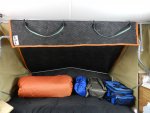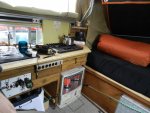Prybry
Adventurer
I use my Dogde pickup and Bethany Pickupper camper for winter camping while I support the race officals with 2 meter Ham radio. see first photo... Note the 25ft mast with 2M/440 antenna and the Yellow "bubble bee" camper parked next to me is the Check point Coordinator for the entire 350 mile event. We trade off radio support dutys during the 5 days. The "Sawbill" Check point served as the finish for the mid distance race and the north bound and south bound rest stop for the Marathon racers. During the race we are sharing info with the main race headquarters in Duluth MN.
My two biggest issues on past Bear Grease trips has been economical heating and heat retention with essentially a pop-up camper top.
The first problem was using the LP forced air furnace… while it worked great and maintained a 70 degree temperature (as long as the door was closed!) The problem is that it used two forms of energy, neither of which I carry a lot of reserve. The 20 lb LP tank lasts about 36 hours with the heater running. The furnace also uses 12vdc power to run the fan. It draws about 5 Amp/hr from a battery with only 175 hr reserve, so about the same 36 hours before I needed to bring out a generator to recharge.
This year I added a kerosene radiant heater good for 10,000 btu… the best part is that it runs with no DC power requirements and lasts 15 hours on a single gallon tank of fuel. I carried (2) 5 gallon jugs of kerosene and only filled twice a day. So for 4 days of camping I maintained a 75 degree interior for $36 in kerosene. The only issue was that the heater has no thermostat so I was adjusting the open window to control the temp. at a comfortable level. Outside temps dropped to 0 F on two nights... daytime temps in the teen's.
As for heat retention, I came up with the idea of using thermal moving blankets on the roof and sides of the pop out wings. This worked great. I did experience some freezing of the blankets to the side walls due to moisture build up, but only where the outer frame pinched the two materials together. I’m sure that the blankets reduced the heat loss through the canvas.
Here are some pictures of the camper setup to support the racers as the main form of communications. The Ham radio is only reliable system as cell towers are too far away to be usable.
The second photo shows the moving blankets drapped inside the side canvas "wings" to retain heat. The hooks on the straps act like clamps on the frame pipes.
The third photo shows the kerosene heater and my stove making hot water for tea... note the open window and FT817 radio in the center. My typical work table is stowed in this photo.
The forth photo shows one of the dog teams leaving the check point.
Enjoy....!
My two biggest issues on past Bear Grease trips has been economical heating and heat retention with essentially a pop-up camper top.
The first problem was using the LP forced air furnace… while it worked great and maintained a 70 degree temperature (as long as the door was closed!) The problem is that it used two forms of energy, neither of which I carry a lot of reserve. The 20 lb LP tank lasts about 36 hours with the heater running. The furnace also uses 12vdc power to run the fan. It draws about 5 Amp/hr from a battery with only 175 hr reserve, so about the same 36 hours before I needed to bring out a generator to recharge.
This year I added a kerosene radiant heater good for 10,000 btu… the best part is that it runs with no DC power requirements and lasts 15 hours on a single gallon tank of fuel. I carried (2) 5 gallon jugs of kerosene and only filled twice a day. So for 4 days of camping I maintained a 75 degree interior for $36 in kerosene. The only issue was that the heater has no thermostat so I was adjusting the open window to control the temp. at a comfortable level. Outside temps dropped to 0 F on two nights... daytime temps in the teen's.
As for heat retention, I came up with the idea of using thermal moving blankets on the roof and sides of the pop out wings. This worked great. I did experience some freezing of the blankets to the side walls due to moisture build up, but only where the outer frame pinched the two materials together. I’m sure that the blankets reduced the heat loss through the canvas.
Here are some pictures of the camper setup to support the racers as the main form of communications. The Ham radio is only reliable system as cell towers are too far away to be usable.
The second photo shows the moving blankets drapped inside the side canvas "wings" to retain heat. The hooks on the straps act like clamps on the frame pipes.
The third photo shows the kerosene heater and my stove making hot water for tea... note the open window and FT817 radio in the center. My typical work table is stowed in this photo.
The forth photo shows one of the dog teams leaving the check point.
Enjoy....!




